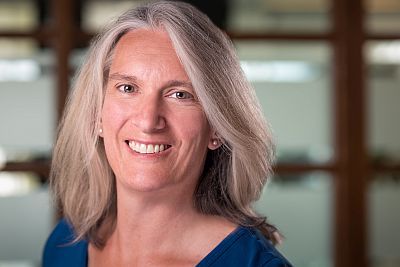
Increasing student engagement through active learning is a top priority for Queen’s Law and now the school has its own in-house Education Innovation Developer. Katherine Prescott (BSc, MEng, BEd) started her new position on July 24, bringing more than 20 years of experience in designing and delivering courses at the secondary and post-secondary levels. With a multidisciplinary background in science, engineering and education, she has taught in the public school system, for Correctional Service of Canada, and at McMaster and Queen's Universities. Most recently, she was designing courses for Queen’s Engineering and Applied Science.
One month into her new role, Katherine Prescott talks about how she’ll be enhancing teaching and learning at Queen’s Law.
What interested you in the position of Education Innovation Developer at Queen’s Law?
KP: I was keen to build on my former responsibilities as an Instructional Designer as well as to explore ways to facilitate positive change in teaching and learning at Queen’s University. I think there is a lot of potential for all members of the Faculty of Law to work together to improve legal education for students, and I was interested in being a part of that change.
What did you do as an Instructional Designer with Queen’s Faculty of Engineering and Applied Science?
KP: In my previous role, I was part of a multidisciplinary team of people who supported teaching and learning in the Faculty of Engineering and Applied Science. As an Instructional Designer, I worked closely with instructors on the design and development of their online and blended courses. Additionally, I assisted instructors with the use of the Queen’s learning management system, onQ, as well as other educational tools.
What was your previous involvement with Queen’s Certificate in Law program for undergraduate students?
KP: I had the pleasure of working as the Instructional Designer and Project Manager for the Certificate in Law courses in Aboriginal Law (LAW 202) and Workplace Law (LAW 203). Together with multi-media specialists, I supported the instructors with developing learning outcomes, course activities, assessments, and instructional videos, and with navigating their courses in onQ.
How are you supporting innovation and technology at Queen’s Law?
KP: At the moment, there are three key areas in which I am supporting innovation and technology at Queen’s Law. The first area relates to the development of online and blended learning opportunities with the new undergraduate Certificate in Law and with other online courses in development. The second area involves the incorporation of innovative educational technologies, such as an artificial intelligence simulation for practising professional skills, in Queen’s Law courses, and the third area involves supporting instructors with ideas for increasing student engagement in their on-campus courses.
How are you involved with the simulation in legal education program for which our school received a $250,000 grant from the Ontario Centre for Excellence?
KP: This project is an exciting one where learners will have an opportunity to practice and hone soft skills, such as those required for effective client service, in a simulated environment before they need to employ these skills in professional practice. My role is to assist with the design, development, testing, and eventual implementation of the simulation.
What are your priorities and goals for education innovation at the Law Faculty?
KP: I think there is a desire among instructors to make Queen’s Law courses more engaging for students, so an immediate priority for me will be to support faculty members who are keen to begin implementing new ideas in their classrooms. Since I’m coming to the Faculty with a background other than law, I would like to spend some time observing law classes and speaking with faculty, staff and students about what they think makes a good legal educational experience. Once I have a better sense of what the current landscape is like, I will be able to form long-term goals that best serve the needs of education programs at Queen’s Law. Ultimately, I would like to foster an environment where faculty, staff, and students can share ideas for improving legal education in the 21st century.